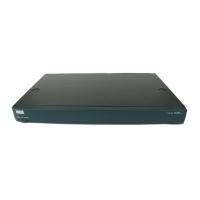2-7
Cisco 2600 Series Routers Hardware Installation Guide
OL-2171-02
Chapter 2 Preparing to Install the Router
Preparing to Connect to a Network
Token Ring can operate at two different ring speeds: 4 and 16 Mbps. All devices on the Token Ring must
use the same operating speed.
Use the provided Token Ring cable to connect the router to a switch. Refer to the section “Token Ring
Port Pinouts” in the Cisco Modular Access Router Cabling Specifications online document for the Token
Ring port pinouts. This document is on the Documentation CD-ROM that accompanied your router
package, and on Cisco.com.
Serial Connections
Serial connections are provided by WAN interface cards and network modules. The WAN interface
cards can be installed in either slot of the 2-slot chassis; the network module can be installed in the
Cisco 2600 series single network module slot. For more information on WAN interface cards, refer to
the Cisco WAN Interface Cards Hardware Installation Guide. For more information on network
modules, refer to the Network Modules Hardware Installation Guide. Both of these documents are on
the Documentation CD-ROM that accompanied your router package, and on Cisco.com.
• For information about installing WAN interface cards, refer to the Cisco WAN Interface Cards
Hardware Installation Guide, located at: Cisco Product Documentation > Access Servers and
Access Routers > Modular Access Routers Cisco 2600 Routers > Hardware installation
documents for Cisco 2600 series > Interface card installation
• For information about installing network modules, refer to the Cisco Network Modules Hardware
Installation Guide, located at: Cisco Product Documentation > Access Servers and Access
Routers > Modular Access Routers Cisco 2600 Routers > Hardware installation documents
for Cisco 2600 series > Network module (netmod) installation
Before you connect a device to a serial port, you need to know the following:
• Type of device, data terminal equipment (DTE) or data communications equipment (DCE), you are
connecting to the synchronous serial interface
• Type of connector, male or female, required to connect to the device
• Signaling standard required by the device
Configuring Serial Connections
The serial ports on the asynchronous/synchronous serial network modules and the serial WAN interface
card use DB-60 connectors. (See Figure 2-1 through Figure 2-6.) Serial ports can be configured as DTE
or DCE, depending on the serial cable used.
Serial DTE or DCE Devices
A device that communicates over a synchronous serial interface is either a DTE or DCE device. A DCE
device provides a clock signal that paces the communications between the device and the router. A DTE
device does not provide a clock signal. DTE devices usually connect to DCE devices. The
documentation that accompanied the device should indicate whether it is a DTE or DCE device. (Some
devices have a jumper to select either DTE or DCE mode.) If you cannot determine the device type in
the documentation, see Table 2-2 to help you select the proper device type.

